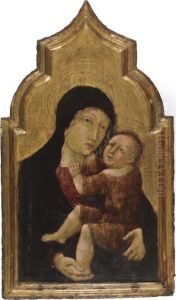Pisano Giacomo Del Paintings
Giacomo del Pisano, also known as Jacopo di Giovanni, was a prominent Italian sculptor whose work marked a significant transition between the classical and medieval traditions to the more naturalistic styles that characterized the Renaissance. Born around 1240, likely in Pisa, Italy, he was part of a family of sculptors, which included his father Giovanni Pisano, a notable sculptor and architect in his own right. This familial connection provided Giacomo with an early exposure to the art and architectural world of the time, grounding his future works in the rich tradition of Italian sculpture and architecture.
Giacomo del Pisano's career spanned the late 13th and early 14th centuries, a period that witnessed the gradual emergence of the Renaissance. Although specific works directly attributed to Giacomo are scarce, his influence is often inferred through association with his father and through works that exhibit a stylistic transition reflective of his time. His contributions are mostly recognized in the context of collaborations with his father, Giovanni, on projects such as the Pisa Baptistery pulpit (completed in 1260) and the Siena Cathedral pulpit (completed in 1268). These works are celebrated for their detailed representation of biblical scenes and figures, and their dynamic compositions that brought a new sense of life to stone.
The sculptures of Giacomo del Pisano are noted for their departure from the rigid and formulaic representations of the earlier medieval period, moving towards a more naturalistic portrayal of the human figure and narrative dynamism. This shift is indicative of the broader changes occurring within Italian art, where there was a growing interest in humanism and the natural world. Though Giacomo's own contributions are often overshadowed by those of his father and later Renaissance artists, his work remains an important link in the evolution of Italian sculpture.
Giacomo del Pisano's exact date of death is uncertain, but he is believed to have died around 1320. Despite the lack of extensive records on his life and work, his legacy is preserved in the craftsmanship and stylistic transitions evident in the sculptures attributed to the Pisano workshop. Through these works, Giacomo played a role in laying the groundwork for the Renaissance, bridging the gap between the Gothic and the emerging humanist aesthetic that would dominate European art.
